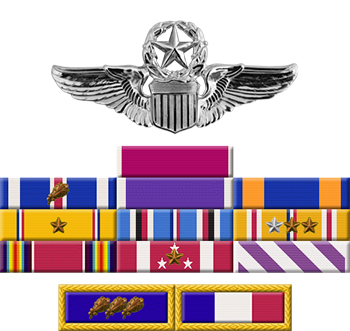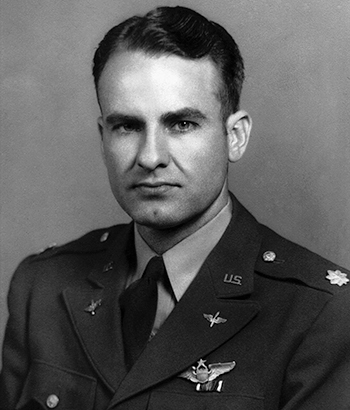
|
James T. "Jim" Connally |
 |
|||
| Rank, Service | ||||
Colonel, U.S. Army Air Forces |
||||
| Veteran of: | ||||
|
||||
| Tribute: | ||||
Jim Connally was born on June 12, 1910, in McGregor, Texas. He attended the Agricultural and Mechanical College of Texas (now Texas A&M University) at College Station, Texas, from 1927 to 1932, and was commissioned a 2nd Lieutenant in the U.S. Army upon graduation as a member of the Corps of Cadets there in June 1932. Lt Connally then attended flight training and was awarded his pilot wings at Randolph Field, Texas, on June 29, 1933, followed by service as an A-3 Falcon, A-8 Shrike, and A-12 Shrike pilot with the 13th Attack Squadron of the 3rd Attack Group at Fort Crockett, Texas, from June 1933 to February 1935. During this time he participated in flying several Air Mail routes from February to May 1934. His next assignment was as a flight instructor at Randolph Field, Texas, from February 1935 to September 1938, followed by service as a B-17 Flying Fortress pilot with the 93rd Bomb Squadron of the 19th Bomb Group at March Field, California, from October 1938 to March 1941. Captain Connally then ferried several B-17 bombers to England and instructed their aircrews on the aircraft for several months, for which the British awarded him their Distinguished Flying Cross for his help. Upon returning to the United States, he moved with the 19th Bomb Group to Albuquerque Field, New Mexico, and then deployed to the Philippines in October 1941. Major Connally served as a B-17 pilot with the 93rd Bomb Squadron in the Philippines from October to December 1941, and then after the Japanese attack he moved with the squadron to Australia in December 1941, to Java in January 1942, and back to Australia in March 1942. During this time he flew the first bombing mission by the United States in World War II on December 19, 1941. He served as Commander of the 93rd Bomb Squadron in Australia from March to April 1942, and then as Commander of the 19th Bomb Group in Australia from April to July 1942. During this time he flew some of the earliest combat missions in the Pacific Theater from Australia. After returning to the United States, Colonel Connally was assigned to the School of Applied Tactics at Orlando Army Air Field, Florida, in November 1942, and he took command of the 9th Bomb Group there in December 1942. He commanded the 9th Bomb Group at Orlando from December 1942 to April 1944, and then served as a B-29 Superfortress pilot and Commander of the 504th Bomb Group at Fairmont Army Air Field, Nebraska, from April to November 1944. Col Connally deployed with the 504th Bomb Group to North Field, Tinian, in December 1944, and served as Commander until transferring to the staff of XXI Bomber Command under General Curtis LeMay on Guam in February 1945. He continued flying combat missions as an observer, and was killed in action aboard the B-29 "Thumper" with the 398th Bomb Squadron of the 504th Bomb Group over Yokohama, Japan, on May 29, 1945. Col Connally's remains were later recovered from Japan and he was buried at Jefferson Barracks National Cemetery in Lemay Township, Missouri. In 1951, Waco Air Force Base, Texas, was renamed James Connally AFB in his honor. |
||||
|
||||

